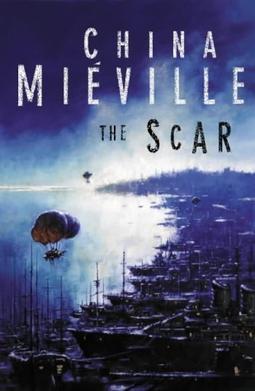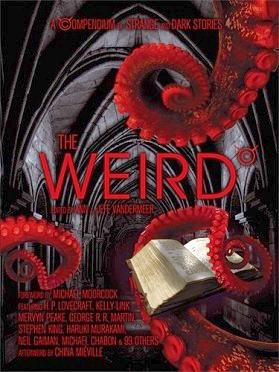
Jeff VanderMeer is an American author, editor, and literary critic. Initially associated with the New Weird literary genre, VanderMeer crossed over into mainstream success with his bestselling Southern Reach Series. The series' first novel, Annihilation, won the Nebula and Shirley Jackson Awards, and was adapted into a Hollywood film by director Alex Garland. Among VanderMeer's other novels are Shriek: An Afterword and Borne. He has also edited with his wife Ann VanderMeer such influential and award-winning anthologies as The New Weird, The Weird, and The Big Book of Science Fiction.

China Tom Miéville is a British speculative fiction writer and literary critic. He often describes his work as "weird fiction", and is allied to the loosely associated movement of writers called New Weird.

The Scar is a weird fantasy novel by British writer China Miéville, the second set in his Bas-Lag universe. The Scar won the 2003 British Fantasy Award and was shortlisted for the 2003 Arthur C. Clarke Award. The Scar was additionally nominated for the Philip K. Dick Award in 2002 and the Hugo Award for Best Novel in 2003. It is set directly after the events described in Perdido Street Station.
Weird fiction is a subgenre of speculative fiction originating in the late 19th and early 20th centuries. Weird fiction either eschews or radically reinterprets traditional antagonists of supernatural horror fiction, such as ghosts, vampires, and werewolves. Writers on the subject of weird fiction, such as China Miéville, sometimes use "the tentacle" to represent this type of writing. The tentacle is a limb-type absent from most of the monsters of European gothic fiction, but often attached to the monstrous creatures created by weird fiction writers, such as William Hope Hodgson, M. R. James, Clark Ashton Smith, and H. P. Lovecraft.

Book the Third: The Wide Window is the third novel of the children's book series A Series of Unfortunate Events by Lemony Snicket. In this novel, the Baudelaire orphans live with their aunt Josephine, who is seemingly scared of everything. The book was published on February 25, 2000 by HarperCollins and illustrated by Brett Helquist.
Notable examples of railways in fiction include:

References to the fictional kraken are found in film, literature, television, and other popular culture forms.
Moby-Dick is an 1851 novel by Herman Melville that describes the voyage of the whaleship Pequod, led by Captain Ahab, who leads his crew on a hunt for the whale Moby Dick. There have been a number of adaptations of Moby-Dick in various media.

The City & the City is a novel by British author China Miéville that follows a wide-reaching murder investigation in two cities that exist side by side, each of whose citizens are forbidden to go into or acknowledge the other city, combining weird fiction with the police procedural. It was written as a gift for Miéville's terminally ill mother, who was a fan of the latter genre. The novel was published by Macmillan on 15 May 2009.
American gothic fiction is a subgenre of gothic fiction. Elements specific to American Gothic include: rationality versus the irrational, puritanism, guilt, the uncanny, ab-humans, ghosts, and monsters.

Urban Gothic is a sub-genre of Gothic fiction, film horror, and television dealing with industrial and post-industrial urban society. It was pioneered in the mid-19th century in Britain, Ireland, and the United States, before being developed in British novels such as Robert Louis Stevenson's Strange Case of Dr Jekyll and Mr Hyde (1886) and Irish novels such as Oscar Wilde's The Picture of Dorian Gray (1890) and Bram Stoker's Dracula (1897). In the twentieth century, urban Gothic influenced the creation of the sub-genres of Southern Gothic and suburban Gothic. From the 1980s, interest in the urban Gothic was revived with books like Anne Rice's Vampire Chronicles and a number of graphic novels that drew on dark city landscapes, leading to adaptations in film including Batman (1989), The Crow (1994) and From Hell (2001), as well as influencing films like Seven (1995).

The Windup Girl is a biopunk science fiction novel by American writer Paolo Bacigalupi. It was his debut novel and was published by Night Shade Books on September 1, 2009. The novel is set in a future Thailand and covers a number of contemporary issues such as global warming and biotechnology.

Moby Dick is a 2010 American science fiction thriller film that is an adaptation of Herman Melville's 1851 novel Moby-Dick. The film is an Asylum production, and stars Barry Bostwick as Captain Ahab. It also stars Renee O'Connor, Michael B. Teh, and Adam Grimes and is directed by Trey Stokes.

Embassytown is a science fiction novel by British author China Miéville. It was published in the UK by Pan Macmillan on 6 May 2011, and in the US by Del Rey Books on 17 May 2011. A limited edition was released by Subterranean Press. The novel's plot involves the town of Embassytown, the native alien residents known as Ariekei, their Language, and humans' interaction with them. The novel was well reviewed and won the 2012 Locus Award for Best Science Fiction Novel.

The Weird: A Compendium of Strange and Dark Stories is an anthology of weird fiction edited by Ann and Jeff VanderMeer.

The FantLab's book of the year award are a set of awards given annually for the best science fiction or fantasy works published in Russia during previous year. The awards are named after FantLab web site.

Evan Dahm is an American webcartoonist from Asheville, North Carolina known for creating the Overside universe of webcomics. Dahm has also published a number of print-only graphic novels.












